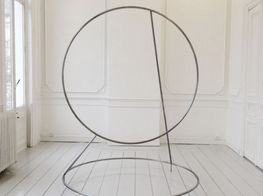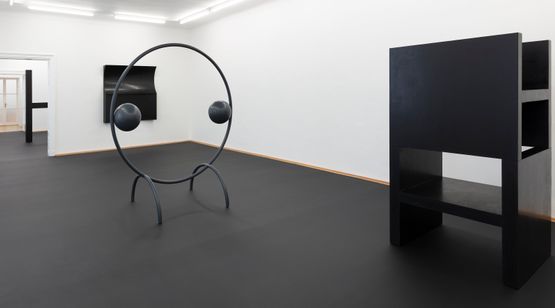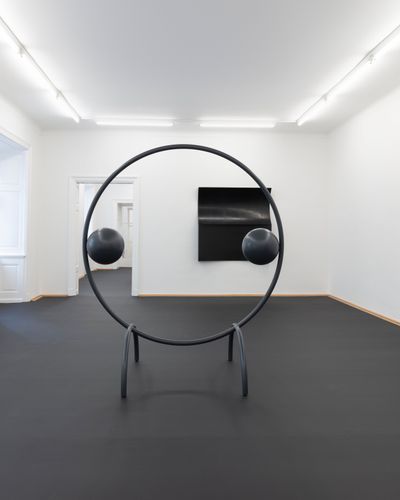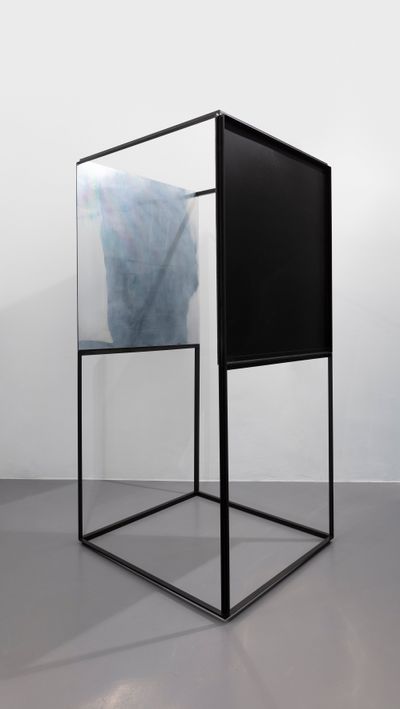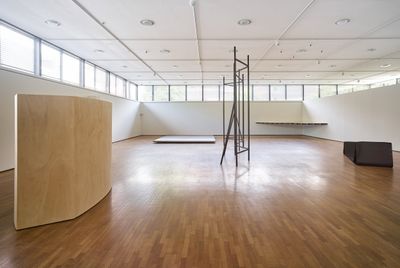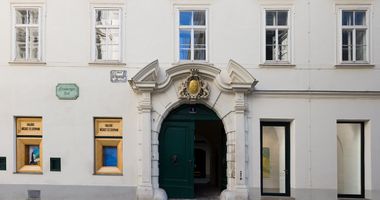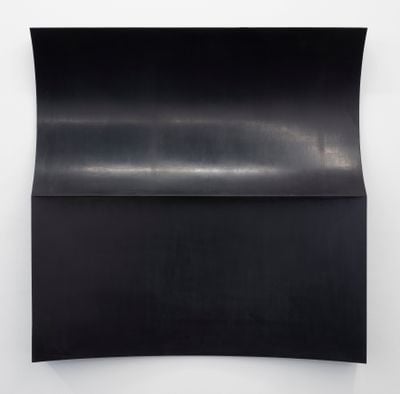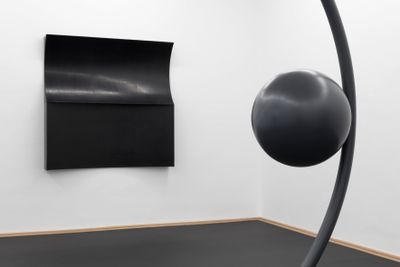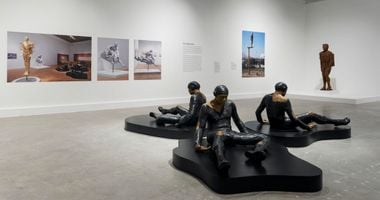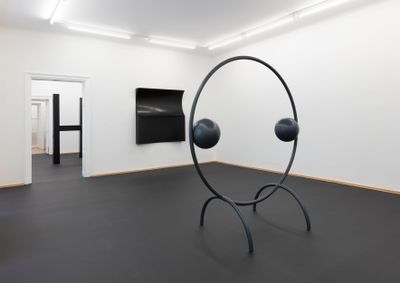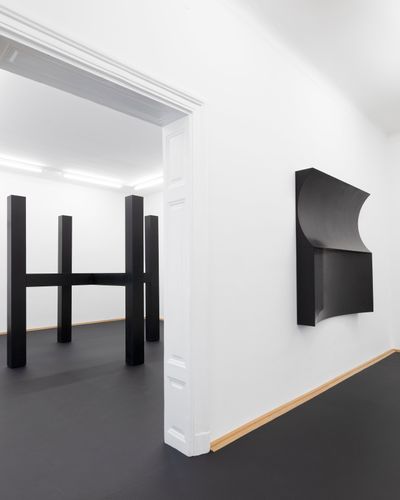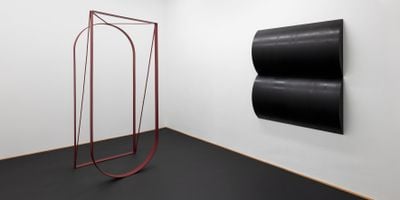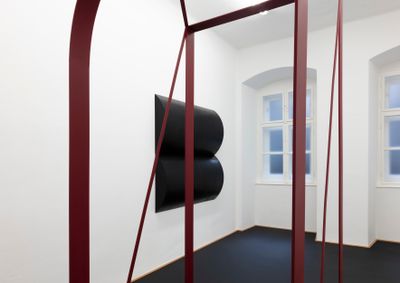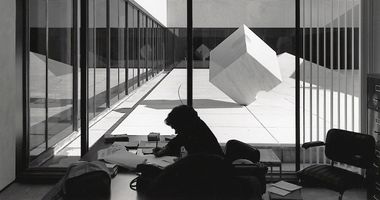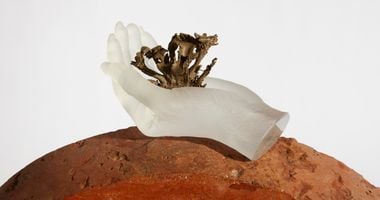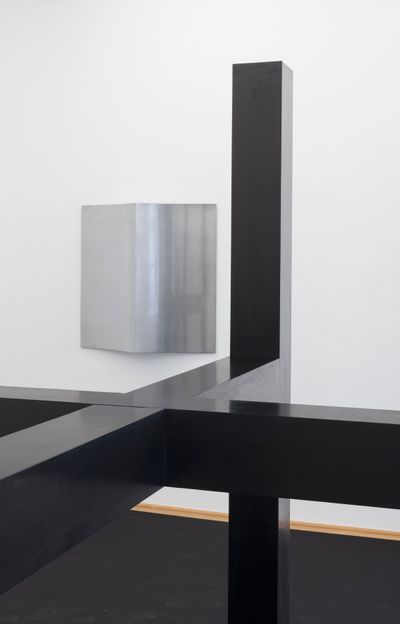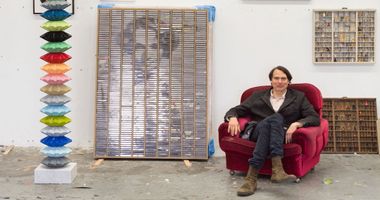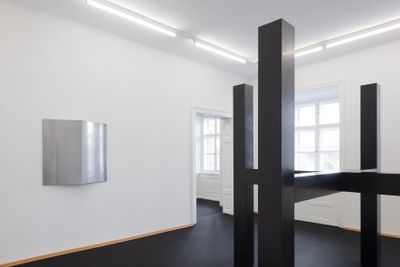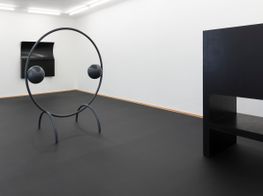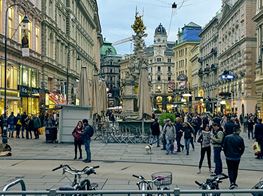Michał Budny: Amplifying Material Ambiguity
Galerie nächst St. Stephan Rosemarie Schwarzwälder | Sponsored Content
Courtesy the artist.
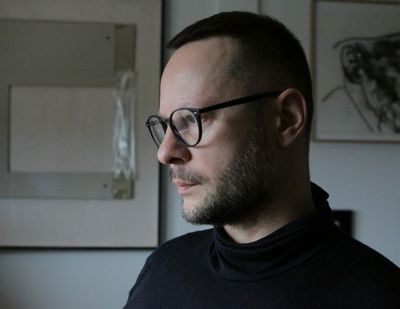
Courtesy the artist.
The curves, crevices, and ridges of Michał Budny's minimalist sculptures and installations take on austere geometric outlines that create a quiet visual poetry in space.
Such is the effect of the artist's latest exhibition at Galerie nächst St. Stephan Rosemarie Schwarzwälder in Vienna (Hatakma, 20 January–26 March 2022), where elegant sculptures line the walls and stand erect in the gallery's spaces, their sleek black shapes determining the flow of visitors.
Budny did not formally train at an art academy; rather, his practice has developed over two decades through self-determined processes of experimentation and inquiry. This has resulted in a unique approach to creating objects that relate emotional states to a process of making and material form.
Whilst earlier works came from a more personal place, with the artist using everyday materials such as cardboard and paper to create minimalistic sculptures, scale and more solid materials such as wood and metal have been embraced in recent years to further emphasise lyrical inquiries into absence and emptiness, all while generating a quiet, but charged mood.
Early examples of these inquiries include his solo exhibition at South London Gallery (Author, 1 October–28 November 2010), where discrete forms dominated the space. Among them empty, softly polished wooden shelves that appeared to have been deformed by the previous pressure of the objects they carried.
As the artist notes in this interview, his works now tackle 'a broader range of themes, and they often occupy space more adamantly, sometimes even trying to dominate or warp it, consciously refusing to fit in.'
Referring to his works as 'sculptural installations', they have the unique effect of communicating weight despite weightlessness and vice versa. At the artist's solo exhibition at Kunstmuseum Luzern (31 October 2020–31 January 2021), for instance, 'bricks' constructed from paper coated in black ink were placed in a grid formation on the ground, their uneven colourings and the slight cracks along their edges suggesting fragility.
In other instances, a smooth monumentality creates a different aura. For the artist's solo presentation at the Modern Gallery of Saarland Museum (1 May–13 September 2015), a site-specific installation in the museum's largest exhibition hall comprised five large-scale objects including a curved wooden wall and a low-lying platform, seemingly hovering in space.
Similarly, the artist's participation in Manifesta 7 in Trentino, Italy (19 July–2 November 2008) included the sculptural installation Tree II (2009), composed of a large wooden disc hovering in the sky above a smaller one below it, the space between the two offering the open-endedness of a drifting thought.
On the occasion of this exhibition at Galerie nächst St. Stephan Rosemarie Schwarzwälder—his fifth at the gallery—Budny reflects on the development of his unique approach to material affect.
TMYour earlier works were smaller in scale, dealing with what you have referred to as 'homely' materials such as cardboard and paper to create minimalist forms. Could you tell me a little bit about how you arrived at dealing with space through simple materials? Did you study sculpture?
MBI never studied anything. The scale of my works is never accidental; its choice is aligned with the intensity of the object's voice.
The small size of my early works and their flimsy materials was significant in that they came from personal, intimate themes. The works emerged instinctively, all at once.
Most of my works are independent; they can work in any space.
The material has to be familiar, from my immediate surroundings. It was not just about using cardboard, but about the fact that the cardboard was once part of a folder or the cover of a notebook with things I drew or jotted down.
Now my works have a broader range of themes, and they often occupy space more adamantly, sometimes even trying to dominate or warp it, consciously refusing to fit in.
TMWhat had you been working on through the 1990s, and how did that period influence your practice?
MBI mainly associate the 1990s with my family home, and with an abundance of feelings and the development of simple yet profound dreams. Our house always had tonnes of people in it; there was a constant stream of discussion. It was a time for learning about my capabilities, and a time of upheaval.
I left that home in search of my own story. My parents understood that and helped keep me from the temptation of remaining in one place.
At that point, I was making my first spatial objects, which were vastly enlarged impressions of my own skin. I was immersed in experimentation—not with techniques, but with my own ways of expressing myself.
TMI have read that you have never worked in a studio. Are the sculptures that you create always specific to the spaces that you present them?
MBI don't work in a studio. Some time ago, I had a space, but I only visited it three times over three years before I realised it was pointless. In my case, the studio just creates an aura of routine. In some respects it carries too many obligations, and that makes it too confining.
Most of my works are independent; they can work in any space. Some of them can also work in any conditions.
I have only made a few objects or interventions specific to a particular space. The best examples might be those from the Silence exhibition at Johnen Galerie in Berlin in 2007, and Between at Kunstverein Düsseldorf in 2011.
In Berlin I filled the exhibition space with one enormous levitating object. In Düsseldorf I filled the space with eight larger installations that allowed me to generate an impression of emptiness in the room.
At Kunstverein, I could control the intensity of the works' statements and their techniques as I went along, as they were being created on the spot, in the gallery.
In Berlin, the installation of the work had to be preceded by decisions and technical plans, with no opportunity to change them during the installation, owing to their technical solutions and safety conditions.
The technical precision and the careful composition of the works in the existing space in Düsseldorf gave them weight, and the cardboard used for the large-format object in Berlin made the content lighter in tone.
TMI understand that drawing is an important part of your process. Is this a fluid, daily practice that you then translate into sculpture once something starts to take form? What does this process of translation look like?
MBI'm interested in experiences, and the attempt to dismantle them. For me, drawing is only how I note my observations. It is not meant to serve as a base for my spatial works, though it could suggest some solutions. I look to my drawings for potential creativity in other forms, not just visual ones.
TMDespite not working in the studio, your work does reference traditional art forms such as painting. Have you held a painting practice yourself? In what ways does painting influence your work?
MBQuite recently, I used free strokes of paint or ink on large-format paper. The resulting compositions were experimental. Like my drawings, I treat them as notes.
The format of those painted notes were primarily dictated by the desire to experience the medium combined with the physicality of my entire body, which corresponded to the theme of the paintings, involving the power and tension in the natural world in which I was working.
TMWhat other traditions or movements have influenced your work? Are there any key figures who were integral in your artistic development?
MBThe logic of craftsmanship and observing artisan practices affects my consciousness of responsibility for production. This can be dangerous. You can get stuck in artisanship and lose the art, or an awareness of it.
If I process my basic materials right, this allows me to enhance the ambiguity of my works.
TMReturning to my first question around materials, your works have shifted to include metal and wood, alongside embracing larger scale. Yet you still manage to maintain a connection to the organic nature of the materials you deal with, particularly in the fluidity of forms that you create.
Could you tell me a bit about your journey with materials? How is the process of finding materials that result in the surfaces and outcomes you desire, particularly when you do not work in a studio?
MBWhen I know what I would like to make a piece about, I decide on its form. It is often one of several alternatives. Then I choose the material to correspond with the statement. My work never starts with the material.
If I process my basic materials right, this allows me to enhance the ambiguity of my works. For instance, a corroded steel surface automatically raises questions about its future, and thus its past and present as well, undermining its stability, strength, and often its content as well.
The rubber surface of an unwieldy object changes its perception the moment we approach it. The odor begins to have its effect, and when you touch it, you begin to feel that this seemingly uniform object has another consistency.
Of course, I can easily imagine that I could use a material I have never used before or a medium I have never explored.
TMYour works embody this remarkable sense of stillness. It is something that speaks to the stillness and solitude that many of us have experienced over the last few years, both inside but also the experience of empty urban spaces. How have the last few years influenced your work?
MBThe early pandemic period chaotically and forcibly asserted some structuring questions, one of which was about the point of continuing to make art. And then once again, about who I was or am in life, and why.
That was an important moment that helped me recall my dreams and groundless faith in my capabilities and to be ready for the consequences of the new reality, including death. I stopped being afraid.
Over the past two years I have unexpectedly made many new friends. I know how to converse again—something I haven't done for a long time—and I am working much more intensively than at any time before.
TMWhat does your exhibition in Vienna reflect of these developments?
MBI don't yet have the distance I need to give a clear answer to that question, though I get the impression that my voice is becoming more confident, and also more articulate. —[O]

